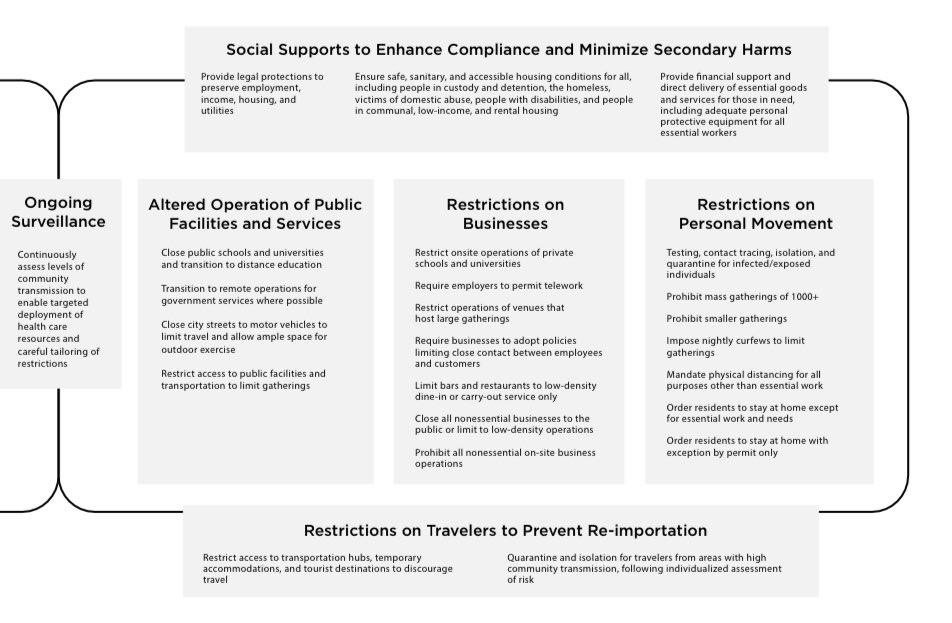Catch-all terms like "lockdown" and "reopen" aren& #39;t helpful ways of thinking about the months & years ahead.
More helpful to think of a ladder or a dial.
We& #39;ll need to gradually adjust our levels of physical interaction up & down from time to time & place to place.
/1
More helpful to think of a ladder or a dial.
We& #39;ll need to gradually adjust our levels of physical interaction up & down from time to time & place to place.
/1
States have adopted varying levels of restrictions on individuals (e.g., bans on gatherings, mandatory shelter in place orders) and businesses/orgs (e.g., closure gathering places like theaters & bowling alleys, prohibitions on all nonessential business ops outside of homes).
/2
/2
States (and local govts in some places) have also altered public operations (e.g., public school closures or transition to distance ed) and provided supports (along w/ some federal support) to enable compliance & minimize secondary harms.
/3
/3
Calling it a "lockdown" misses a lot. It reinforces idea that personal restrictions should be the main focus, when what& #39;s really needed for an effective response may be a combination of closed gathering places, strong recommendations to minimize contacts & enabling supports.
/4
/4
By the same token, "reopening" doesn& #39;t mean flipping a switch & going back to normal. There are major differences among the approaches states are taking to easing restrictions. Lumping them together as states that are "reopening" isn& #39;t helpful.
/5
/5
States adopted varying restrictions in March/April and they’re easing varying restrictions now, in May, & beyond. Moving up the ladder, turning down the dial.
/6
/6
E.g., GA Gov.& #39;s decision to lift mandatory state-wide stay at home order may be reasonable... if he weren& #39;t also reopening theaters, bowling alleys, etc. where large groups gather indoors ... & if he weren& #39;t blocking local govt& #39;s from imposing greater restrictions as needed
/7
/7
Lumping all of these decisions together and calling them "reopening" suggests all-or-nothing choice. And focusing on state-level choices to "lockdown" or "reopen" misses that many states are large and geographically diverse. Local conditions vary & so should responses.
/8
/8
Statewide rules may have been justified for a brief time to assess conditions and let hotspots surface, but the time for statewide restrictions may have passed. A growing number of governors (e.g., CO & CA) are highlighting the need for different responses in different areas.
/9
/9
Even in the absence of widespread testing, it& #39;s clear that community transmission is severe in some places, but it is also apparently low-to-no in other places.
/10
/10
Social/ec/geographical conditions also vary, including ability to engage in various activities in a physically distanced way and availability of alternatives to on-site activities
/11
/11
E.g., beaches. In some places, e.g., Chicago, Miami, beaches may be crowded places where it& #39;s impossible to physically distance. In others, e.g., parts (not all) of SC, GA, FL, beaches may be the main place people can take walks for exercise (w/ plenty of room to spread out).
/12
/12
Also: shopping for nonessentials. Here in the DC suburbs, I can get lots of nonessentials delivered at home. In Alaska (which has announced on-site non-essential shopping can resume w/ density limits), many travel long distances to purchase onsite b/c delivery is limited.
/13
/13
So... restrictions do & should vary from place to place. And not all restrictions are on equal footing. E.g., restrictions on large gatherings and closures of places where people tend to congregate indoors are probably going to be needed in more places & for longer durations.
/14
/14
Unless we think we should be mandated (w/ crim penalties) to stay at home for several months to years, restrictions also need to vary from time to time - easing restrictions for a while, then re-tightening if hospitalizations surge, threatening to overwhelm capacity.
/15
/15
Easing-retightening w/ widespread testing is definitely safer than doing it while testing is still inadequate, but testing is finally ramping up.
/16
/16
And some restrictions (e.g., closing places where individuals/household groups can spend time outdoors) may have been unnecessary from the start, so easing them shouldn& #39;t require satisfying particular testing/gating criteria. If it gets too crowded, limits can be re-imposed.
/17
/17
Easing/retightening/tweaking for the next year+ will require:
- Clear communication & discussion of goals
- Management of expectations re possible retightening
- Widespread public trust & cooperation, which are eroded when the harshest restrictions are left in place too long.
/18
- Clear communication & discussion of goals
- Management of expectations re possible retightening
- Widespread public trust & cooperation, which are eroded when the harshest restrictions are left in place too long.
/18

 Read on Twitter
Read on Twitter


